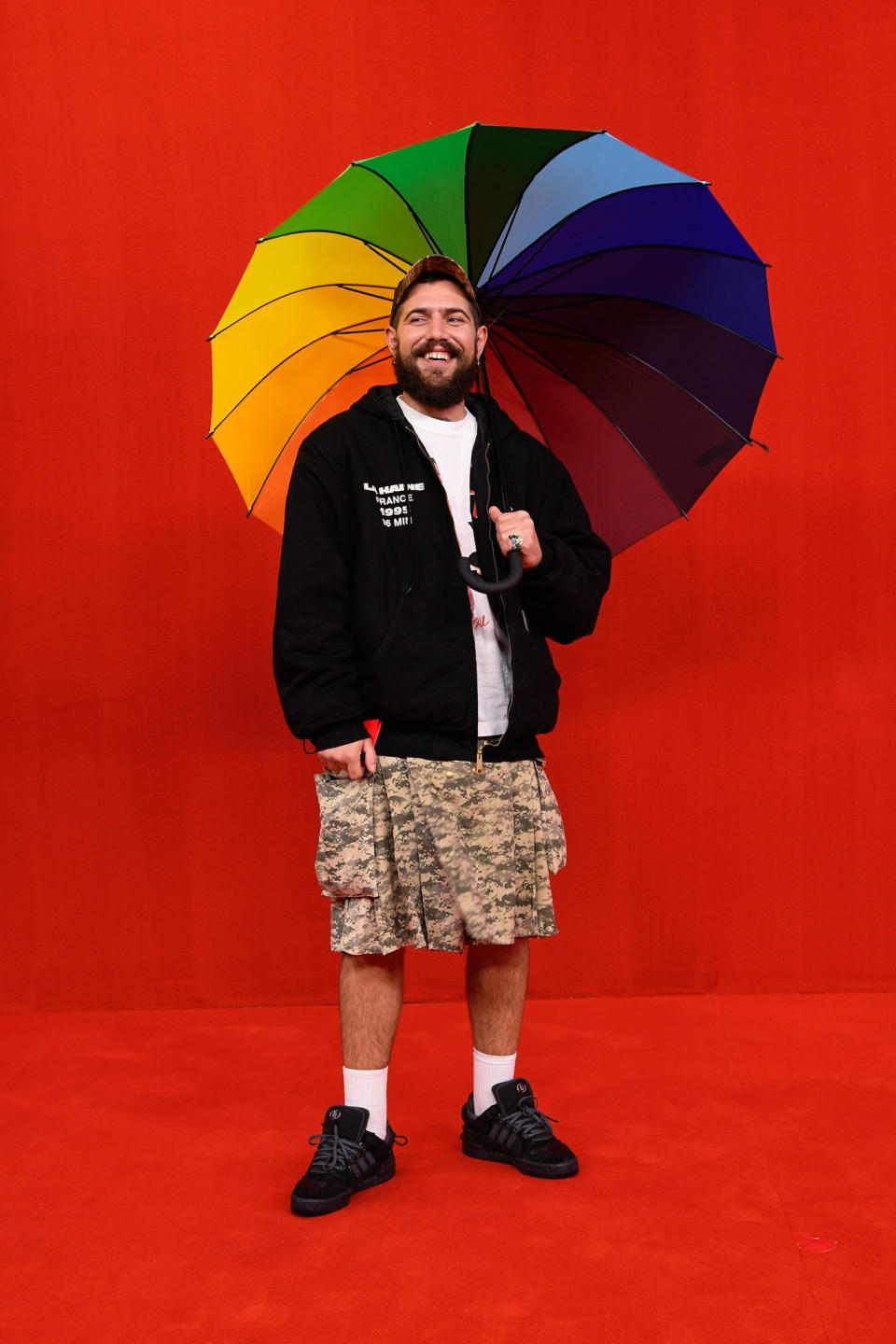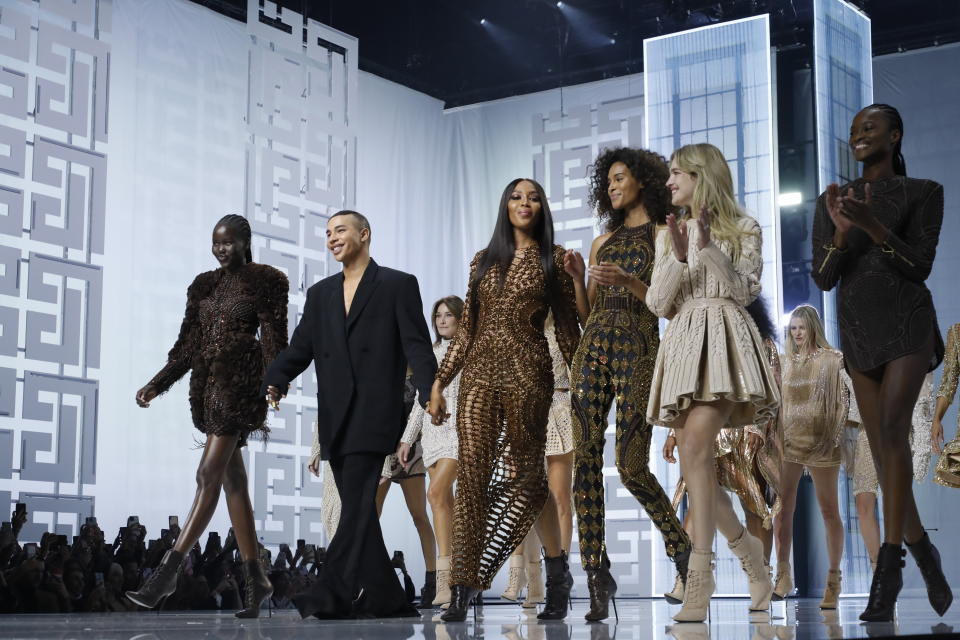What to Watch: Can Paris Fashion Week Really Become Inclusive?

PARIS — After 18 months of restrictions linked to the coronavirus pandemic, the most recent edition of Paris Fashion Week marked not just a return to in-person events, but also a more inclusive approach to fashion shows.
Members of the public flocked to outdoor displays and celebrations such as Olivier Rousteing’s 10th anniversary at the helm of Balmain. But with the French government once again tightening the screws in a bid to curb another wave of COVID-19 infections, will the apparent democratization of Paris Fashion Week prove a blip on the landscape, or a lasting trend?
More from WWD
Last fall’s open-air shows by Rick Owens, Chloé and Saint Laurent drew curious onlookers, who were as thrilled by the spectacle as by sightings of celebrities like Blackpink’s Rosé and actress Demi Moore. Valentino’s Pierpaolo Piccioli treated the streets of Paris like his runway, with models exiting the show venue to display his spring 2022 creations in front of locals seated on restaurant terraces.
“We’re experiencing a euphoria of human contact,” said Patrizio Miceli, head of creative agency Al Dente. “Fashion has become festive again.”

Giovanni Giannoni/WWD
Balenciaga’s Demna — who recently dropped his surname — captured the zeitgeist by having his show guests walk a red carpet alongside celebrities including Cardi B and Offset, Mark Tuan, Lewis Hamilton and Naomi Campbell, as well as models and members of his design team dressed in his designs, as dozens of fans braved stormy weather to watch the arrivals.
He capped it off by screening a bespoke episode of “The Simpsons” that toyed with the icy, impassive image of the Balenciaga brand.
Paul-Emmanuel Reiffers, founder and chief executive officer of creative consulting firm Mazarine, said the pandemic has prompted luxury brands to broaden their target customer base.
“I think that everyone has felt post-COVID-19 this effect of being much more open and generous,” said the executive, whose event agency La Mode en Images produced the Balenciaga, Rick Owens and Valentino shows, among others.
“It’s like there is a huge release of energy — everyone wants to feel alive,” he added, speculating that brands may have had an additional motive for sharing their runway moments this season. “Given that there are few foreigners around, that opening up is perhaps a way of being more present with local audiences.”
Guillaume Robic, director of development, communication and events at the Fédération de la Haute Couture et de la Mode, noted that the trend has been gathering steam for a while — and can actually be traced back to 1984, when Thierry Mugler became one of the first designers to fling open the doors of a fashion show to members of the public, with a mega-event at the Zenith concert venue.
“The tendency has been amplified by the pandemic,” Robic said. “Over the last 18 months it’s accelerated both in the physical world and online. We’ve seen an opening up of fashion shows in the physical world, and an amplification of shows online, designed to reach the widest possible international audiences.”
Not everyone is convinced the industry has fundamentally changed. Benjamin Simmenauer, professor at the Institut Fran?ais de la Mode, believes the message sent out by luxury brands is more performative than authentic.
“The current conversation about inclusivity, openness and horizontality is so prevalent in fashion that it’s difficult to build an image around the opposite notion, which is exclusivity,” he said.
“So I think in terms of image, the onus is on organizing events or shows that will be accessible to the public in one way or another, and COVID-19 has really furthered that agenda,” he added.
“From VIP clients to anonymous followers to celebrities, nobody was able to attend shows when they were digital, so I think there was a sort of democratization, in quote marks, at that point, and that it has played a role in brands opting for a more open and accessible image,” Simmenauer continued.
“I think it’s pretty hypocritical the way they’re now shying away from using the word ‘exclusivity,’ even though the caliber of guests at the shows and the price points are only going up. We’re not heading in the direction of democratizing fashion — quite the opposite is true,” he argued.
“In reality, the practices of these houses are not at all inclusive,” he continued. “What that means is that, even though culturally there’s a desire to show that the aristocratic side of couture houses is outmoded, it’s more of a trend or an image than a reality.”
Beyond image, another important consideration is the evolution of communication. At a time when the success of events is increasingly measured by their digital reach, casual onlookers provide a valuable source of amplification.
“The holy grail of communication and marketing is for people to promote your brand for you,” Simmenauer said. “Members of the public are also a major source of influence, all the more so because they’re doing it spontaneously, without being paid, so they’re contributing to building an image of the event that’s unbiased.”

Aitor Rosás Suné/WWD
Al Dente’s Miceli agreed that crowd participation adds to an event’s aura. “Being able to show that there’s a large audience responding to a show gives all the other people that are following the event on social networks even more of a feeling of having lived something,” he said.
And while brands continued to depend heavily on the presence of K-pop stars, including Blackpink’s Rosé, Jisoo and Jennie, and TikTokers such as Noah Beck and Dixie D’Amelio, Miceli said they were increasingly wary of placing too much emphasis on VIP guests.
“They’ve understood today that they can no longer rely just on the front row for media coverage. They’ve become aware of the fragile nature of the front row, which they relied on heavily in the past. These days they have to explore other pathways to visibility,” he said, noting the growing importance of platforms like Twitch, online games and the metaverse.

Aitor Rosas Sune/WWD
Balmain was among the first of the Paris-based brands to usher in a more democratic approach to its shows. In June 2019 it showed its men’s collection as part of a music festival, handing out 1,500 free tickets. In September, the brand expanded the Balmain Festival into a two-day experience, which featured concerts as well as stands offering food, drinks and limited-edition fashion merchandise.
The first 1,200 people who pledged a minimum donation of 15 euros to (RED) and the Global Fund — which address HIV and AIDS — were granted two tickets for the Balmain show, which featured an all-star cast of models, including Campbell, Carla Bruni and Lara Stone, and performances by Doja Cat and Franz Ferdinand.
“It is impossible for me to imagine a creative moment or inspiration without thinking of its accompanying music,” Rousteing said, explaining the rationale for the festival: “To reunite and experience once again the melding together of the beauty of friendship, the power of music and the excitement of a Paris runway.”
One reason the approach has resonated is Rousteing’s huge online fan base. The designer’s fame has been boosted by the release of the documentary “Wonder Boy” on Netflix in June. “Designers are increasingly pop-culture stars,” said Miceli. “More than ever, people follow designers as much as brands.”
Other ways in which brands have made their events more accessible is through temporary installations. Robic cited the example of Dior, which previously commissioned installations by artists Judy Chicago and Eva Jospin for two separate haute couture shows at the Rodin Museum, and subsequently opened them up to the public.
“More and more, there is this desire to share and, in a spirit of generosity, to offer the wider public physical access to experiences linked to the creativity of the houses,” he remarked. “We’ve rarely seen this many events, including cultural and creative happenings, organized by houses and the fashion ecosystem around the official Paris Fashion Week calendar.”
Meanwhile, brands have steadily augmented their digital content, in order to drum up interest in virtual presentations — an effort supported by the Fédération de la Haute Couture et de la Mode, which tapped data research and insights company Launchmetrics to create a digital platform for Paris Fashion Week in 2020.
One example was Louis Vuitton’s spring 2021 women’s wear show, held at the La Samaritaine department store.
The event provided three experiences: one for seated guests amid the Art Nouveau splendor; a second for remote special guests, who received links that allowed them to control 360-degree cameras with their smartphones or tablets, and a third for those viewing the livestream, which layered on additional content and visual effects with the use of a green screen and other technologies.
With YouTube and Tencent partnerships, the Paris Fashion Week platform drew 1 million unique visitors, 4 million page views, and close to 1 billion video views in 2021, Robic reported. “The fashion week of September-October 2021 garnered 250,000 visitors, 1 million pages views, and a Media Impact Value of $297 million, which is the biggest ever seen for any fashion week,” he said.
The figures suggest that efforts to become more inclusive will continue apace.
“It’s a phenomenon of sharing and creative amplification. It goes with the fact that fashion has been very much linked to photography, animation and film for several decades. But now fashion is also increasingly linked to all the scenic arts, choreography, visual arts and gaming,” Robic said.
“That all ties in with reaching out to broader audiences and new generations, and so for me, it’s a phenomenon that’s destined to last,” he concluded.
SEE MORE:
Olivier Rousteing Reflects on a Decade at Balmain
Newsmaker of the Year: Balenciaga’s Demna
Buyers Hail Strong Paris Collections as the Simpsons Steal the Show
Best of WWD
Sign up for WWD's Newsletter. For the latest news, follow us on Twitter, Facebook, and Instagram.